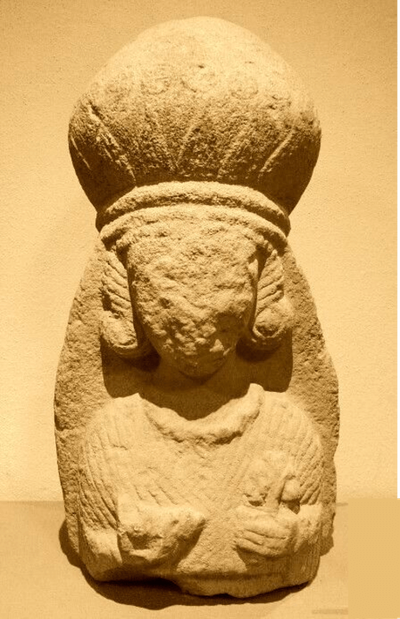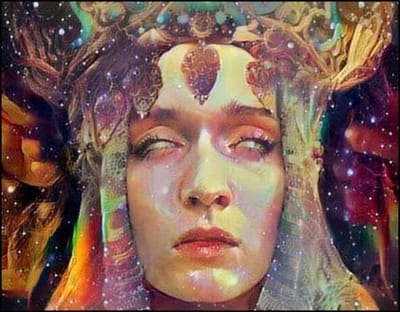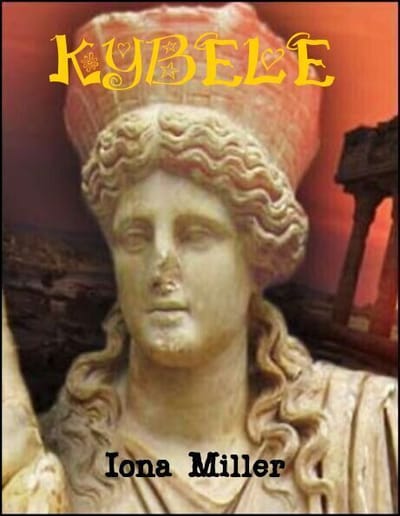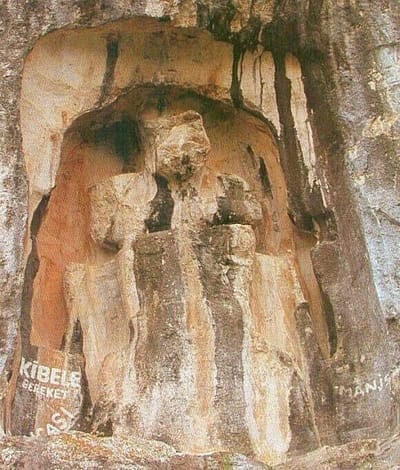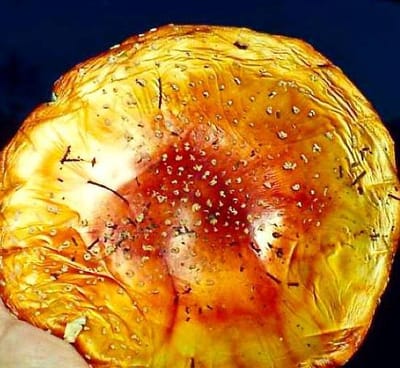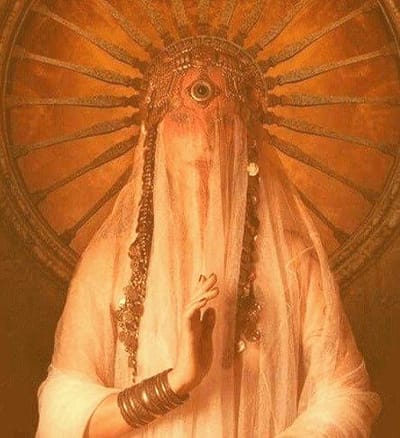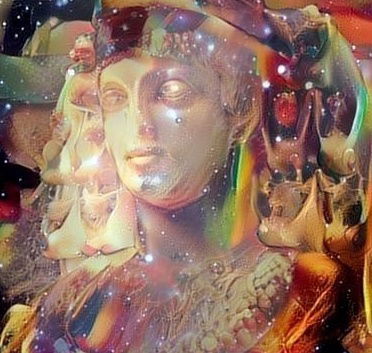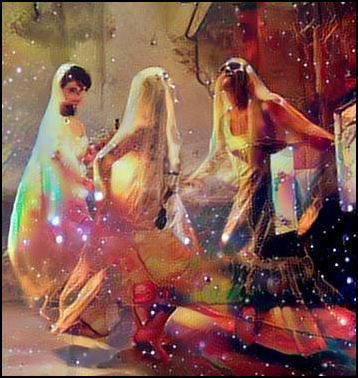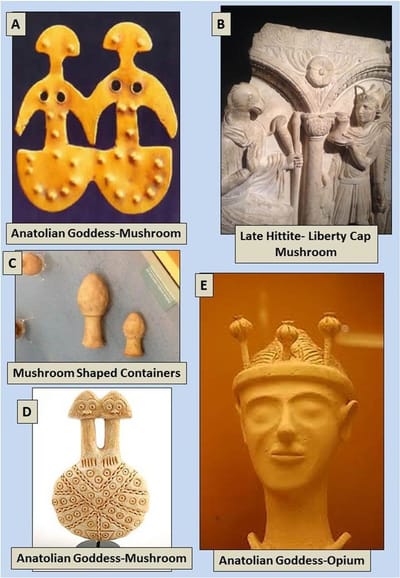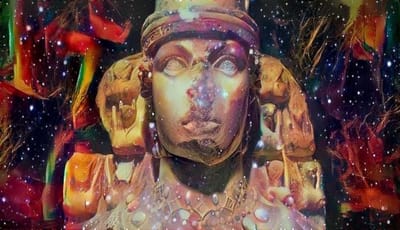Articles
https://ionamiller2020.weebly.com/cybele.html We cannot forget that ancient people sought to alter their consciousness for preternatural seeing. Rhythmic dancing, auditory-driving with rhythmic sound patterns, and hyperventilation can produce ecstatic trance states. Thought-lives manifest belief systems. All religions have an ecstatic component and all religions alter consciousness to some extent.
Read Morehttps://ionamiller2020.weebly.com/kybele-attis.html The Asiatic goddess and her cult-partner arose long before the classical era of belief. She is the Phrygian goddess of magic, wild things, and faith -- the dark mysteries of earth and nature. Phrygians originally worshiped their goddess in an aniconic fashion, like the Thracians who before being influenced by the Greeks never depicted their goddess anthropomorphically. (Bogh, 2007) Generally, she is characterized by a dual nature of unpredictable power and beneficent qualities. We are not proposing a discounted universal goddess theory or matriarchy (Gimbutas 2001). Instead we have to look for evidence derived from an experience of the sacred and artifacts. Arguably, it is a mystery religion, which requires undergoing ordeals, a death-like epxerience and suffering.
Read MoreJung introduced the notion that archetypes, ancient gods and goddesses, are dynamic patterns that eternally operate in our lives and our world. They are the primal driving forces of humanity and nature. Their metaphysical influence pervades the whole spectrum of domains from cosmic to subatomic. Theirs is the fabric that weaves Above and Below together, seamlessly, as a holographic whole. Our worldviews, basic assumptions about the way the world is, are grounded and sustained with mythic patterns which condition our beliefs, thoughts, feelings and actions. Personal mythology is a vibrant infrastructure that informs your life, consciously or unconsciously. Fixed patterns of belief and behavior function as trances. Living mythically means becoming aware of our personal and collective origins. Their articulation opens up new experiential space. These forms structure our awareness; in them we find the root cause of our difficulties and our healing. Solutions to intrapersonal conflict is a first step toward solving global conflict. https://ionamiller2020.weebly.com/cybele.html
Read Morehttps://ionamiller2020.weebly.com/cybele.html Sing to me O Muse, clear voiced daughter of great Zeus, Of the mother of all gods and of all men. In the din of rattles and drums and in the sound of pipes she delights. In the howl of wolves and the roar of glaring lions, in resounding mountains and wooded glands she finds her joy (Homeric Hymn 14). Any time in the wilds of Earth now brings solace, without which we lose our psychological and spiritual footing as the ongoing litany of loss, corruption, degradation, aggression, death and trauma that is the daily news assaults us all. It is in nature, and loving nature with all our hearts on a daily basis, where we find the equanimity necessary to continue walking forward into our increasingly broken world. "Even if the recollection of mythology is perhaps the single most characteristic move shared by all 'archetypalists', the myths themselves are understood as metaphors—never as transcendental metaphysics whose categories are divine figures. ... Myths do not ground, they open." [James Hillman, Archetypal Psychology: A Brief Account. Dallas: Spring, 1983, p. 20]
Read MoreCommunal Shamanism Robert Graves first suggested her myths were hazy Greek recollections. Distant shamanic-totemic tribes lived in mountain woods and made brews from raw Amanita muscaria in order to induce prophetic vision, heightened sexual energy, senselessness, and incredible physical strength. With trance and possession, drama is another shamanic experience -- the evocation of deceased ancestors. "In the eastern Mediterranean, these ecstatic cults were most often held in honor of a great mother goddess and her perennially dying-and-rising consort. The goddess‘ religious dramas enacted in cultic ritual stressed the importance of fasting, drumming, trance-inducing music, self-mutilation,and a non-alcoholic ritual intoxication. Far and wide the dying consort worshiped by these cults was a god of vegetation, ecstasy, revelation,and salvation; by ingesting his body initiates underwent a profound mystical experience." (Attrell) She is distinct from, but connected to Rhea by idea, assimilation, and history. The effects of the cult of Kybele were closely connected with the Chaldean Oracles. They were savants, diviners, astrologers, and magicians of Babylonia. The Greeks incorporated Oriental legends into their own mythologies. "The Hittites worshiped Teshub, the great god of mountain summits and of the thunder — whose symbolic emblems were the hatchet and the bull — and the great goddess, prototype of the Greek Kybele. After settling in Asia Minor and occupying Cappadocia, Phrygia, Lydia, Pontus and parts of Armenia and Cilicia, the Hittites began, in the twentieth century B.C., to make forays also into northern Syria and Mesopotamia." Great depth is hidden in her roots. Anatolia was steeped deeply in mythology. Storytelling was likely an important part of her culture and tradition with songs, tales and myths being passed down regularly from one generation to another, ensuring their stories remain told and their value enriched. The range of meaning contained in every symbol can be regarded as an illustration not only of metaphysical principles but also of higher levels of reality. As an Oriental or Semitic earth goddess, she was celebrated with fiery nocturnal passions, furious and orgiastic rituals -- beating of drums, crashing of loud cymbals, blowing of horns, and clashing of armor. We presume an antic origin for continuity of the symbol and icon which must be taken at face value. If they depicted the goddess as a mushroom, she is still a mushroom. Her mycological history is likely her longest cultural thread, convoluted as the mycelium that gives it root as a widely-practiced phenomenon (also in Dionysus and Mithras cults). Her records were carved on living stone monuments which time has not effaced. Symbolism and historicity are only superficially irreconcilable. Almost all transcendental events appear to be both historical and symbolic at once—seen simply as symbolic matter transformed into legend then into history. Probably the earliest Anatolian female figure connected with felines, dating to the pre-pottery, pre-agricultural Neolithic, no later than 8000 BCE, has been found in level II of the southeast Anatolian site of Göbekli Tepe, north of the Harran plain, in southeastern Turkey. The figure is carved in an area between pillars containing depictions of felines (Schmidt 2006:238, figure 104). She had a role in Phyrigian burials. The rosette, a radiant fungal solar cap, one of her attributes, has been found in ancient royal burial sites. Ionian motifs of rosettes and lion heads imply the relation to the Phrygian goddess. "Symbolism adds a new value to an objector an act, without thereby violating its immediate or “historical” validity. Once it is brought to bear, it turns the object or action into an “open” event: symbolic thought opens the door on to immediate reality for us, but without weakening or invalidating it; seen in this light the universe is no longer sealed off, nothing is isolated inside its own existence: everything is linked by a system of correspondences and assimilations." (Eliade, Cirlot) https://ionamiller2020.weebly.com/kybele-attis.html
Read MoreRitualized Ecstasy Kybele's image is of unutterable sanctity, both in horror and in reverence. Ritualized processing of intoxicants, ecstasy, and local populations thrived. Sacrifice occurred in the groves, and orgies in the caverns that echoed and roared with frenzy. They enticed their dead god back up the axis mundi like a serpent from the underworld, the heart of the Goddess‘ rites. In these groves, trees were hewn into images of the Divine Bridegroom, a nameless god, whose phallus was called out from the earth for ritual consumption. On the forest floor, Amanita muscaria itself appears as a blazing red fire glowing beneath the pine. Historically, the cult first emerged from the sacred caverns and groves at Gordium, the legendary city of King Midas (738-696 BCE). More likely, her hidden cult was introduced there. There must have been a strong unconscious emotional interest and appeal for other centers of worship popped up like mushrooms -- 23 highland monuments. Her first lavish temple was built in the early Phrygian period, around the eighth century BCE. The meteoric idol of the Mother really came from there. Her secret identity is a continuation of primitive, animistic thought. They must have been thunderstruck by such firefall. They knew what it was and where it came from -- not in scientific terms, but in terms of their collective mythic lives. More recently Antonin Artaud used the motif metaphorically. "And there is a luminous point where all reality is rediscovered, only changed, transformed, by -- what? -- a nucleus of the magic use of things. And I believe in mental meteorites, in personal cosmogonies." Kybele was linked to Dionysus. Attis, Adonis, Bachus, Bromius, Tammuz, Pan, Sabazius, Serapis, Zalmoxius, Zeus, and Orpheus himself - are replicas of their grand primordial archetype Dionis. The variations which appear among them resulted from the transplantation of the god from one region to another. The migrating Phrygians brought the Dionis/Sabazius cult with them when they settled in Anatolia in the early first millennium BCE. The pinecone that tipped his Thyrsus linked him to Kybela (lat. Cybele), another Brygo/Phrygian primordial deity. This phallic scepter tipped with a pinecone (symbolizing pineal gland/third eye) was also his emblem; the potent panther was his totem-animal, The god's origins trace to Macedonia, (Pelagonia and Paionia in Upper Macedonia, the Phrygian's ancestral homeland). The story of Attis also originated here. A eunuch priest, Atys traveled from Pessinus to Sardis, the Lydian capital at the foot of mount Tmolos, where 'the ancient goddess, Kubaba, from Mesopotamia and the Phrygian goddess first appear to have merged.' (Gough, 2014) Kybele is virtual, chaotic, and autochthonous. The Roman orator, Marcus Tullius Cicero (106 – 43 BCE), said the Anatolian goddess was revered, ‘by all the kings who have ever held rule in Europe and in Asia.’ She eventually refracted into competing narratives, many of which contain residue of past paradigms lost in the mists of deep time. The essence of all phenomena is a vibrant rhythm, the intimate nature of phenomena is directly perceptible by polyrhythmic human consciousness. For this reason, imitating is knowing. The echo is the paradigm of imitation and initiation. Her ordeal was a psychedelic metaphysical journey.
Read MoreVeiled Goddess Plant In the raw wilderness, the wildest of all the plants was the seedless mushroom, which defied cultivation. More than a sacred plant it was the living goddess. While the earliest Phrygian reference to Kybele dates from the 7th century BCE, evidence shows previous cultures likely worshiped a maternal goddess figure. "Up until c. 1200 BCE, Troy was considered the stronghold of the Bosporus, but when Troy fell so did the Hittite Empire. The Thracian conquerors from the Balkans were ancestors of the Phrygians. (CAA: 19.) The ancient Phrygians settled in central and western Anatolia and Midas was one of their illustrious sovereigns. King Midas advanced a major civilization, which was strongly influenced by Neo-Hittites and Urartians (Vannics/Chaldeans). (ACRT: 14.) The Capital was Gordion and the National Goddess was Phrygian Matar Cybele plus her son – lover Attis." (CAA: 18-20; MG: 398-400.) https://www.academia.edu/36598140/171._750-650_Cybele_and_King_Midas_Anatolia.pdf?email_work_card=view-paper Hallucinogenic mushrooms have been found in the remains of the southeast European Vinca culture from the Danube, dated to 5000 BCE. Did the practice move through Thrace to Phyrgia or was it indigenous? Early Anatolian inscriptions have been found and deciphered from facades, niches, arches, or other rock monuments. Some reliefs display Kybele standing in a mythical doorway, the magical gateway between the divine and regular worlds. Phrygian Kybele is powerful and demanding. Her mysterious cult following is centered around her lover Attis who castrated himself. How and why did the Phrygians develop this cult and elevate the fascinating deity, Kybele? This is a fierce androgynous goddess with a transgendered son-lover, whose original shamanic cult can be associated through her own artifacts with the use of psychoactive mushrooms, likely used since Paleolithic times. A riveting stare is consistent with a visionary state.
Read Morehttps://ionamiller2020.weebly.com/kybele-attis.html The cult of Kybele-Attis concerns fundamental love of imagination, and communion with the goddess by amplifying that primordial imaginal capacity and inherent urge. Because such love is obsessively self-referential, it is symbolically incestuous, an introversion to an imaginal character in an imaginal realm. The 'fantasy principle' is more fundamental than even the 'pleasure' or 'reality' principles. Old academic cult models of automatic ascending development are obsolete and presumptuous. Over time, her Phrygian cults and iconography were transformed from her archaic meteoric and monumental rock-cut images in the Phrygian highlands. Her mysteries were private rites with a chthonic aspect. They were eventually subsumed by the influences and interpretations of her Greek, Roman and other foreign devotees. This ancient and mysterious figure has been altered so many times, we don't know her true origin or meaning. More than a fertility icon, the mountain-cave goddess is the doorway to the mystical encounter that leads to rebirth. Her perfect image is breath -- wind, soul, breath of creation, breath of life. Rather than a vegetation-god, Attis the personification of an intoxicating sacred plant, linked to the pine tree that hosts the visionary mushroom, its miraculous mystery fruit. It mimics the androgynous male/female metamorphosis central to the myth. (Ruck)
Read MoreIona Miller is a nonfiction writer for the academic and popular press, clinical hypnotherapist (ACHE) and multimedia artist. Her work is an omni-sensory fusion of intelligence, science-art, new physics, symbolism, source mysticism, futuring, and emergent paradigm shift, and mythic studies, creating a unique viewpoint. She is interested in extraordinary human potential and experience, and the EFFECTS or unexpected consequences of doctrines of religion, science, psychology, and the arts. Miller practiced as an innovative Clinical Hypnotherapist through the 1980s and 1990s. She now enjoys active retirement and writing in the Rogue Valley in So. Oregon, USA.
Read MoreThe Asiatic goddess and her cult-partner arose long before the classical era of belief. She is the Phrygian goddess of magic, wild things, and faith -- the dark mysteries of earth and nature. Phrygians originally worshiped their goddess in an aniconic fashion, like the Thracians who before being influenced by the Greeks never depicted their goddess anthropomorphically. (Bogh, 2007) Generally, she is characterized by a dual nature of unpredictable power and beneficent qualities. We are not proposing a discounted universal goddess theory or matriarchy (Gimbutas 2001). Instead we have to look for evidence derived from an experience of the sacred and artifacts. Arguably, it is a mystery religion, which requires undergoing ordeals, a death-like exerience and suffering. She is usually represented seated on a throne with a phiale (a libation bowl) and a tympanon. She has formidable, awesome, magical powers. People come to her to seek vengeance or justice, and she can possess individuals with madness or illness, or cure them from disease (Borgeaud 1996:27ff.; Roller 1999:156). Roller demonstrates, there is no divine Attis until Hellenistic and Roman times, but this doesn't preclude more archaic antecedents when the goddess was worshiped alone. Other symbols were later transferred to Kybele. The Roman version of the cult differs greatly from the cult in the ancient Phrygian homeland of Kybele.
Read MoreThe forbidden fruit of the mythic tree is Amanita muscaria (Ruck). Different toxins and alkaloids prevail depending on the concoction. We can't be sure if the divine entheogen was abandoned or replaced by surrogates, but it induced a visionary reality and cohesive worship. It was euphemistically and symbolically known as the "bull" for its power. We don't know if the divine elixir was a single substance or a mixture. Psilocybin and Cubensis mushrooms were also found on the plains. Drug-induced initiations were practiced throughout the known ancient world with mushrooms, opium, ephedra, cannabis, ergot, acacia, henbane, Syrian rue (mountain rue; Peganum harmala), datura, and more. In Sacred Mushrooms of the Goddess, Ruck (p. 73-84) describes the Lesser Mysteries of Artemis as based on the wild mushroom. They pushed human experiential boundaries to their limits and beyond the agonies of ecstasy. Modern reports of ingestion in wine describe energetic states, a strong desire to dance followed by sedative effects around 3 hours, and intense dreamlike trips for hours. "The effects of Amanita muscaria are diverse and vary according to dosage, method of preparation and the cultural and psychological expectations of the consumer. A small dose (or the initial effect of a larger one) causes bodily stimulation and a desire for movement and physical exercise. Responses to the fly-agaric varied widely. Sometimes an intoxicated individual had to be restrained from over-exerting himself, whilst on other occasions it would induce a tranquil state of bliss in which beautiful visions appeared before the eyes. The effects can be divided into three basic stages, which sometimes overlap. About fifteen minutes after taking the mushrooms the stimulating effects begin and there is much loud singing and laughing. This stage is followed by auditory and visual hallucinations in conjunction with the sensation that things increase in size."
Read More